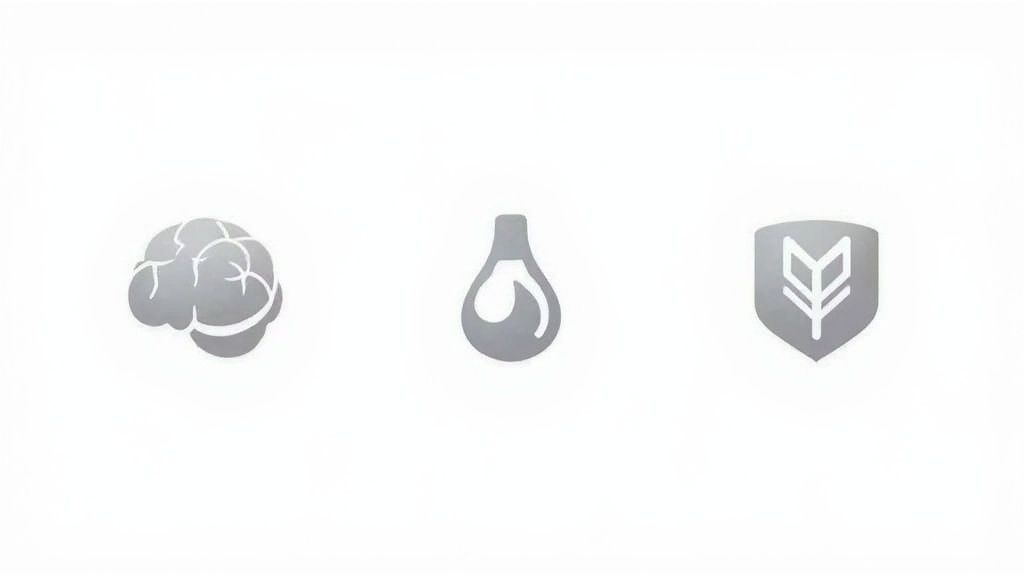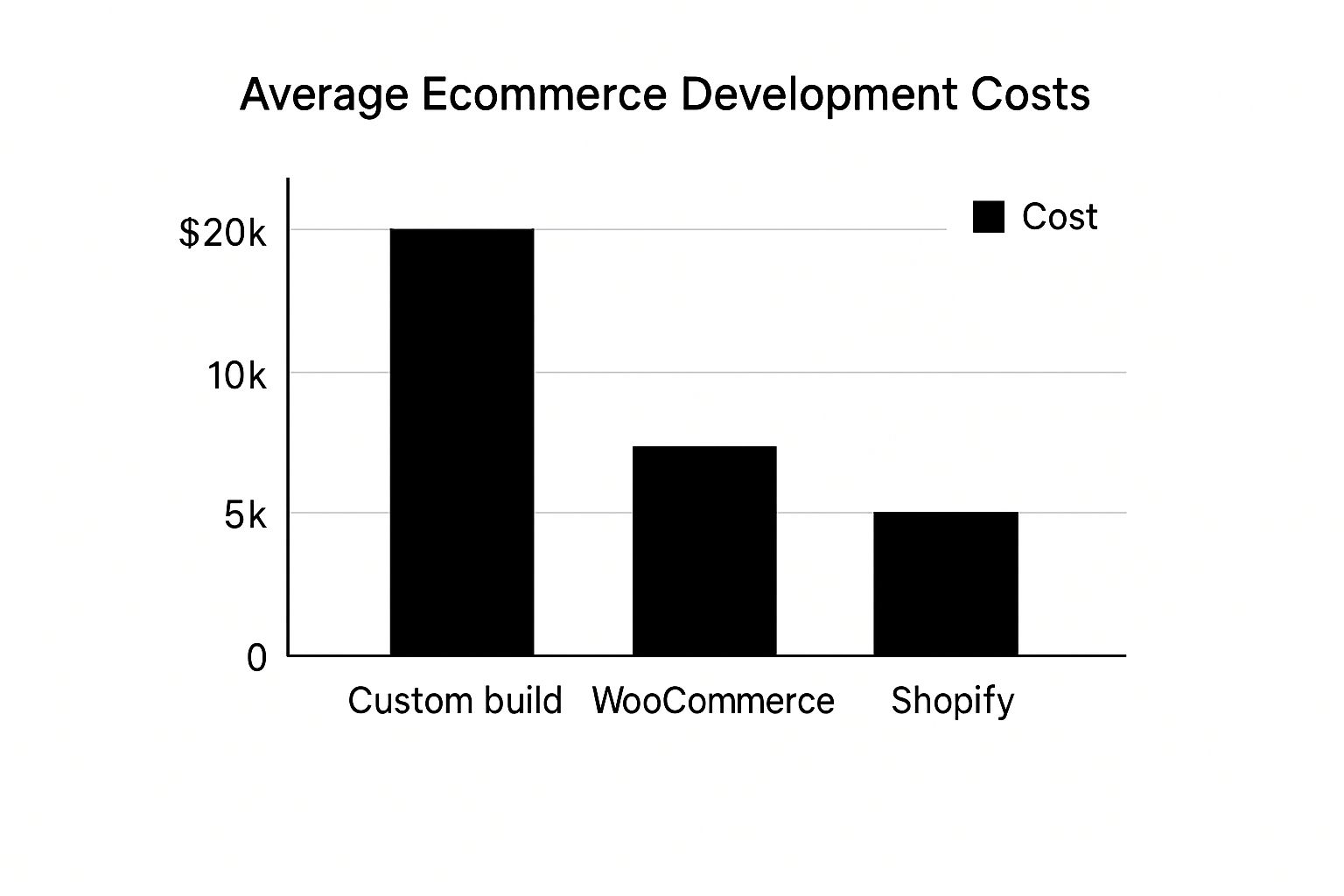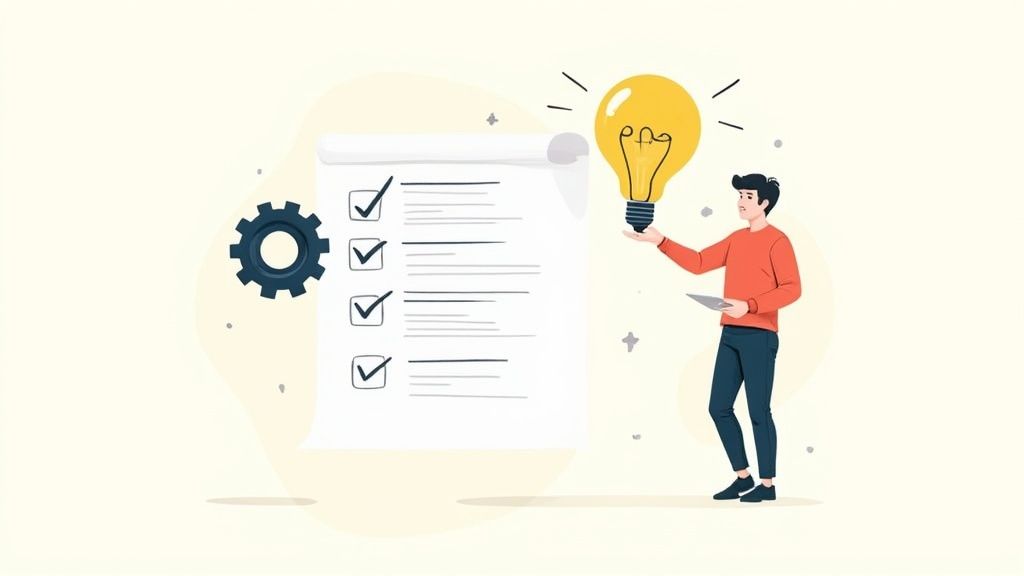Understanding The Real Investment Behind Online Stores
Let's cut through the marketing jargon and talk frankly about what it actually costs to build an ecommerce website. Asking for a standard ecommerce website development cost is a bit like asking, "How much does a house cost?" There's no single, simple answer. A cozy one-bedroom bungalow has a vastly different price tag than a sprawling six-bedroom mansion complete with a pool. In the same way, the final price of your online store is shaped entirely by what you're building.
This is why your neighbor’s $5,000 online store might be perfect for their small side hustle but could easily crumble under the weight of serious customer traffic. In contrast, established businesses often invest $50,000 or more into their digital storefronts to make sure they are secure, scalable, and dependable. The difference isn't just a prettier design; it's about the core architecture. A basic website is like a storefront window—it looks nice, but you can't buy anything from it. An ecommerce site is the entire store: the window display, the cash registers, the stockroom, the security system, and the customer service desk, all working in sync.
The Hidden Complexity of Online Retail
Many people don't realize the deep infrastructure needed to run a store online. It’s not just about displaying products; it’s about managing a complex business operation in a digital space. Several key functions drive costs well beyond those of a simple informational website:
- Payment Processing: Securely handling sensitive credit card information requires robust, compliant systems. This isn’t a simple contact form; think of it as a digital Fort Knox.
- Inventory Management: The website must track stock levels accurately and in real-time—sometimes across multiple warehouses—to prevent the nightmare of overselling products you don't have.
- Customer Accounts: Building secure user profiles where customers can view order history, save addresses, and access loyalty programs adds another significant layer of technical work.
- Shipping and Logistics: Integrating with various shipping carriers, calculating real-time rates, and managing the entire fulfillment process are major technical hurdles.
- Hosting and Security: An ecommerce site needs more powerful hosting to handle sudden traffic spikes (like on Black Friday) and requires constant security monitoring to defend against online threats. If you're exploring options, our guide to affordable web hosting solutions for businesses can be a good starting point.
Ultimately, your investment will mirror the project's complexity and its importance to your business strategy. In 2025, the cost to develop an ecommerce website typically falls between $10,000 and over $250,000, with these intricate features being the main drivers. You can find more ecommerce website pricing from industry experts to see how these factors play out. Accepting this reality is the first step toward budgeting for a platform that won’t just launch but will truly grow with your business.
Where Your Development Hours Actually Go

When a quote for a website build includes over a thousand development hours, it’s fair to ask where that time is spent. An ecommerce website development cost isn’t just for making things look pretty; it's an investment in building a complex digital machine.
Think of it this way: a basic informational website is like a static billboard. It displays information effectively, but that’s where its job ends. An ecommerce site, on the other hand, is a fully functioning retail store. It needs a secure bank vault for transactions, an automated warehouse for inventory, and a 24/7 customer service desk—all working in perfect harmony.
This complexity is why a business-grade ecommerce project demands a significant investment. Data suggests the average cost can be around $60,000, which often breaks down to roughly 1,000 development hours. You can discover more insights about website development costs to get a fuller picture. These hours are dedicated to engineering systems that process money, track inventory, and safeguard sensitive customer data.
How Time Translates to Functionality
So, where do those hours really go? A huge chunk of the budget is allocated to backend development and integrations. These are the behind-the-scenes engines that customers never see but absolutely depend on for a smooth experience. Some of the most time-intensive tasks include:
- Payment Gateway Integration: This is much more than adding a “Buy Now” button. Developers spend weeks making sure the site communicates securely with banks, handles declined payments or errors gracefully, and meets strict PCI DSS security rules to protect customer card information.
- Inventory Management Systems: For any business holding physical stock, developers must build logic to track every product, manage SKUs, update availability in real-time as sales occur, and send low-stock alerts. This is critical to avoid the costly error of selling items you don’t actually have.
- Custom Business Logic: Do you offer product bundles, special pricing for wholesale clients, or a monthly subscription box? Each of these unique business rules requires custom code, extensive testing, and careful integration to ensure it doesn’t break other parts of the site.
To put the ecommerce website development cost into perspective, let's compare it to other common website types. The table below shows just how much more complex—and costly—an online store is.
Website Development Cost Comparison by Type
Compare development costs and time requirements across different website types to understand ecommerce complexity.
| Website Type | Average Cost | Development Hours | Complexity Level |
|---|---|---|---|
| Basic Blog | $1,000 – $5,000 | 20 – 60 | Low |
| Brochure Site | $5,000 – $15,000 | 60 – 150 | Medium |
| Ecommerce Store | $20,000 – $100,000+ | 250 – 1,500+ | High |
As you can see, the leap to ecommerce involves a major increase in both time and financial investment.
Trying to cut corners on these core functions might save some money upfront, but it almost always leads to security gaps, lost sales, and a frustrating customer experience—problems that can cost thousands more to fix later on.
Platform Decisions That Shape Your Entire Budget

Choosing your ecommerce platform is like picking the foundation for your house. If you select one that's weak or poorly suited for your vision, you're setting yourself up for constant problems. Eventually, you'll face an expensive and disruptive rebuild. This single decision heavily influences your entire ecommerce website development cost, both at the start and for years to come. It sets the rules for everything from initial setup fees to your long-term operational expenses and your ability to grow.
At first glance, a platform like Shopify seems incredibly appealing. Many businesses start their journey here, attracted by the low monthly prices advertised. However, what begins as a bargain can quickly become more expensive than you planned. The true cost isn't in the subscription fee but in the entire ecosystem built around it.
Beyond the Subscription: The Real Platform Costs
That tempting low monthly price is just your ticket to get in the door. To operate a store with all the features you need, you will run into several other expenses that add up fast:
- Transaction Fees: Many platforms take a percentage of every sale unless you use their specific payment processor. For a business with growing sales, these fees can easily amount to thousands of dollars each year, cutting directly into your profit margins.
- App and Extension Costs: Do you need advanced search, a customer loyalty program, or subscription options? Each of these functions often requires a paid third-party app. These apps come with their own monthly fees, ranging from $10 to over $100 per app. A store with just five essential apps could see its monthly bill jump by $200+.
- Customization Limitations: As your brand finds its footing, you'll want to build a unique customer experience. The standard themes can feel restrictive, and hiring a developer for even small changes on a closed platform can be surprisingly pricey.
The True Price of a "Cheap" Start
It's a familiar story: a business launches on a budget-friendly platform and finds early success. Before long, they need more custom features than the platform can handle, or they realize their transaction and app fees have become unmanageable. The only way forward is a difficult and expensive migration to a more flexible system, like WooCommerce, or a fully custom solution. This move can cost tens of thousands of dollars and disrupt your business operations.
When you look at the complete picture, the average cost to build and run a new store in 2025 starts at around $29 per month for the basic platform subscription alone. But that’s just the starting line, not the entire race. You can explore detailed ecommerce cost analyses to get a better grasp of these ongoing expenses. The most important takeaway is to choose a platform not just for where your business is today, but for where you want it to be in two years.
DIY, Freelancer, Or Agency: What Actually Saves Money
Choosing who builds your online store is a critical fork in the road, one that directly shapes your ecommerce website development cost. The big question is whether to build it yourself (DIY), bring on a freelance developer, or partner with a professional agency. The option that looks most "affordable" on paper isn't always the one that saves you money in the long run.
The DIY path, using powerful platforms like Shopify or Squarespace, often seems like the most budget-friendly route. However, this approach demands a huge investment of your personal time—time that could be better spent on product sourcing, marketing, or connecting with customers. The real expense here is the opportunity cost. Every hour you spend wrestling with a stubborn design element or a buggy plugin is an hour you’re not actively growing your business.
The Hidden Costs of Cutting Corners
Hiring a freelancer often feels like the perfect middle ground. You get professional expertise without the hefty price tag of an agency. This can be a smart move, especially for specific jobs like theme customization or setting up a particular feature. However, we've seen projects where a cheap DIY or freelance job went sideways, resulting in expensive and time-consuming rebuilds.
A poorly secured website can lead to data breaches, costing thousands in fines and shattering customer trust. Slow performance can send potential buyers clicking away in frustration. And a site not built with growth in mind might need a complete, costly overhaul just as your business starts to gain momentum.
The infographic below shows how initial development costs can differ based on the approach you take.

As you can see, platform-based solutions have a lower entry cost than custom builds, but this doesn't capture the full picture of long-term expenses or the value of expertise. To help you weigh these factors, here’s a more detailed comparison.
Development Approach Cost Comparison
This table offers a complete cost breakdown, comparing the DIY, freelancer, and agency options while considering hidden costs and your time investment.
| Approach | Initial Cost | Time Investment | Hidden Costs | Long-term Value |
|---|---|---|---|---|
| DIY | $0 – $500 | Very High (Weeks to Months) | Opportunity cost, theme/plugin fees, learning curve, potential for costly errors. | Good for simple stores and learning, but may require a rebuild as business scales. |
| Freelancer | $1,000 – $10,000 | Medium (You manage the project) | Project management time, vetting candidates, potential for scope creep, limited support. | Excellent for specific tasks and mid-sized projects. Value depends on freelancer quality. |
| Agency | $10,000 – $100,000+ | Low (Agency manages everything) | Higher upfront investment. | Professional, secure, and scalable result. Ongoing support and strategic partnership. |
This table makes it clear that the "cheapest" route isn't always the most cost-effective. The initial savings of a DIY approach can be quickly erased by the time you lose and the potential for expensive mistakes.
Finding the Smartest Path
An agency might have the highest initial price, but you're paying for an entire team: a project manager, designers, developers, and QA testers dedicated to ensuring your website is secure, scalable, and professional from day one. The real savings often come from getting it right the first time.
For more complex projects, especially on a flexible platform like WordPress where the possibilities are vast, it's wise to consider professional help. For instance, if you need specialized functions that go beyond a standard template, you may want to hire a WordPress developer who deeply understands the platform’s capabilities.
Ultimately, the right choice hinges on your technical skill, budget, and growth ambitions. A smart strategy could be a hybrid approach: start with a solid platform, then hire freelancers for specific enhancements as you grow. You can save the full agency partnership for when you’re ready to scale aggressively and take your business to the next level.
Features That Make Or Break Your Budget
When you're mapping out your ecommerce website development cost, it's important to realize that not all features are created equal. Your total budget isn't one flat number; it's a sum of the individual costs for each function you decide to include. Think of it like building a custom car: the basic model will get you from A to B, but adding a high-performance engine, a top-tier sound system, and a custom paint job will quickly drive up the final price.
In the same way, some features that seem simple on the surface can have a major impact on your budget. Learning to prioritize is the key to managing your costs. You need to separate the features you absolutely need for launch from those that can be added later once your store starts turning a profit.
Must-Haves vs. Nice-to-Haves
To launch successfully, your online store needs a core set of features that work without a hitch. These are the non-negotiables that form the very foundation of your customers' shopping experience.
Core Must-Haves (The Essentials):
- Secure Payment Processing: This is more than just adding a "Pay Now" button. Integrating payment gateways like Stripe or PayPal involves strict security measures (like PCI compliance) and complex error handling, making it a key cost driver.
- Basic Product Pages: You need clear, functional pages that showcase high-quality product images, detailed descriptions, pricing, and an obvious "Add to Cart" button.
- A Functional Shopping Cart & Checkout: This is the heart of your operation. It must be simple, secure, and reliable to keep customers from abandoning their carts.
- User Account Creation: Giving customers the option to create an account makes it easier for them to track orders and speeds up future purchases, which helps build loyalty.
Nice-to-Haves (Phase Two Features):
- Advanced Search Functionality: A basic search bar is expected. However, implementing advanced filters, predictive text suggestions, or image-based searching is a much bigger task, potentially costing anywhere from $500 to over $50,000.
- Customer Reviews & Ratings: These are great for building trust, but you can easily add this feature later with a third-party plugin or as a custom update.
- Wishlists and "Save for Later": While these features definitely improve the shopping experience, they aren't essential for making that first sale.
- Loyalty Programs: Rewarding your repeat customers is an excellent growth strategy, but it’s most effective once you have a consistent flow of orders to work with.
The overall appearance, or web designing layout, also plays a huge part in the cost. A fully custom, highly interactive design will be far more expensive than starting with a pre-built theme. By focusing on the essentials first, you ensure your initial investment is funneled directly into the features that will start generating revenue right away. You can learn more about how design choices impact your project in our detailed guide.
The Ongoing Costs That Catch Everyone Off Guard

The initial ecommerce website development cost is a major milestone, but it's only the first step of a longer financial marathon. Many new store owners get a real shock after launching their site when the recurring monthly expenses start rolling in. Budgeting only for the launch is like buying a new car but completely forgetting you'll need to pay for gas, insurance, and regular oil changes. These ongoing costs aren't optional extras; they're the fuel that keeps your business running, secure, and growing.
Countless entrepreneurs are blindsided as these operational costs pile up, turning what looked like a profitable business into a constant financial scramble. From hosting that needs to keep up with your traffic to payment fees that nibble away at every sale, these expenses can determine your success or failure. Understanding and planning for them is absolutely essential.
Your Post-Launch Budget Checklist
Once the launch day excitement fades, your focus needs to shift to managing these continuous operational costs. It's important to remember they aren't fixed; many will scale up right alongside your business's growth.
Hosting and Maintenance: Your website needs a home on the internet. Basic hosting can be as low as $5–$30 per month, but as your visitor numbers grow, you'll require more powerful—and pricier—solutions to prevent your site from crashing. This can easily climb to $120-$800 per month for stores with high traffic. Don't forget regular maintenance for security patches and software updates; it's a vital investment to protect your store and your customers' data.
Payment Processing Fees: This is simply the price of admission for selling online. Each time a customer buys something, your payment gateway (like Stripe or Shopify Payments) takes a percentage. The standard fee is typically around 2.9% + 30¢ per transaction. While that sounds small, it's tied directly to your revenue and can quickly become a significant expense on your monthly reports.
Marketing and SEO Tools: A fantastic website is invisible without marketing. Subscriptions for email marketing platforms, SEO analysis tools such as Ahrefs, and social media management apps are crucial for reaching customers. These monthly fees add up fast, often tacking on an extra $100 to $500+ to your operating budget.
Apps and Plugins: The special features that make your store unique, like customer loyalty programs or advanced product reviews, often come from apps. Many of these have their own monthly subscription fees, which can range from $5 to over $100 per app.
By planning for these ongoing expenses from the start, you can build a realistic budget that supports healthy growth. This ensures your initial ecommerce website development cost serves as a solid foundation for long-term success, not a financial trap.
Smart Investment Strategies That Actually Work
Knowing the numbers behind an ecommerce website development cost is one part of the puzzle. The other, more critical part, is investing that budget wisely. A successful online store isn't about throwing money at the problem or, conversely, cutting corners so deep you compromise quality. It's about being strategic with your resources. Smart entrepreneurs get the most value from every dollar, transforming their initial spending into a strong foundation for future growth. Think of it less like buying a pre-packaged product and more like making a calculated investment.
One of the best ways to manage your budget is through phased development, which is a business-friendly way of saying you should launch a Minimum Viable Product (MVP) first. Imagine opening a restaurant. You wouldn't build a sprawling, five-star dining hall before you even know if people like your food. You’d start with a pop-up kitchen or a food truck to test your menu. The same idea applies here. Go live with the absolute essentials for a sale: compelling product pages, a secure checkout, and a reliable way to take payments. This approach lets you gather real customer feedback, spreads your costs over time, and ensures you invest in features people actually use, not just the ones you think they want.
Where to Invest and Where to Wait
Figuring out what to prioritize is key to keeping your budget in check. Some features are worth paying for upfront because they prevent bigger, more expensive problems later. Others can easily wait until your business has gained some momentum.
Invest Upfront:
- Scalable Hosting: Starting with a hosting plan that's a little bigger than you need right now is a smart move. It stops your site from slowing down as your traffic increases. Migrating a slow website is a much bigger headache and expense than paying a few extra dollars a month from the beginning.
- Professional UX/UI Design: A confusing checkout is the fastest way to lose a sale. Investing in a clean, intuitive design for your main shopping path ensures you aren't leaking money from day one. This doesn’t require a fully custom design; a well-chosen, premium theme customized for your brand works perfectly.
- Solid Security: Never skimp on security. This includes SSL certificates and trusted payment gateways. A single data breach can shatter customer trust and lead to thousands in damages, destroying your reputation overnight.
Wait for Phase Two:
- Advanced Loyalty Programs: These are fantastic for customer retention, but they work best once you have a steady stream of returning customers.
- Complex Search Filters: A simple search bar is usually enough when you're just starting. Advanced filtering becomes necessary only when your product catalog grows large enough to be hard to navigate.
- Mobile App: A mobile-friendly website is a must-have. A dedicated mobile app, however, is a significant investment. It's best to wait until you have a loyal, established audience that would benefit from an app-specific experience.
Negotiating for Long-Term Value
The way you structure your agreement with a developer or agency can have a huge effect on your total cost. Always insist on a clear, detailed contract that spells out project milestones, what will be delivered, and the payment schedule. This practice protects everyone and prevents scope creep—the dreaded slow expansion of project requirements.
When you negotiate, aim for a long-term partnership instead of just the lowest price. A developer who truly understands your business goals can provide strategic advice that saves you money far beyond the initial website build.
By using a phased approach, prioritizing features intelligently, and setting up clear agreements, you can turn your ecommerce website development cost into a powerful and efficient investment in your business’s future.
Ready to turn your vision into a reality with a smart, strategic investment? At KP Infotech, we specialize in building scalable, high-performance ecommerce solutions that grow with your business. Let's discuss a development plan that fits your budget and your goals.
